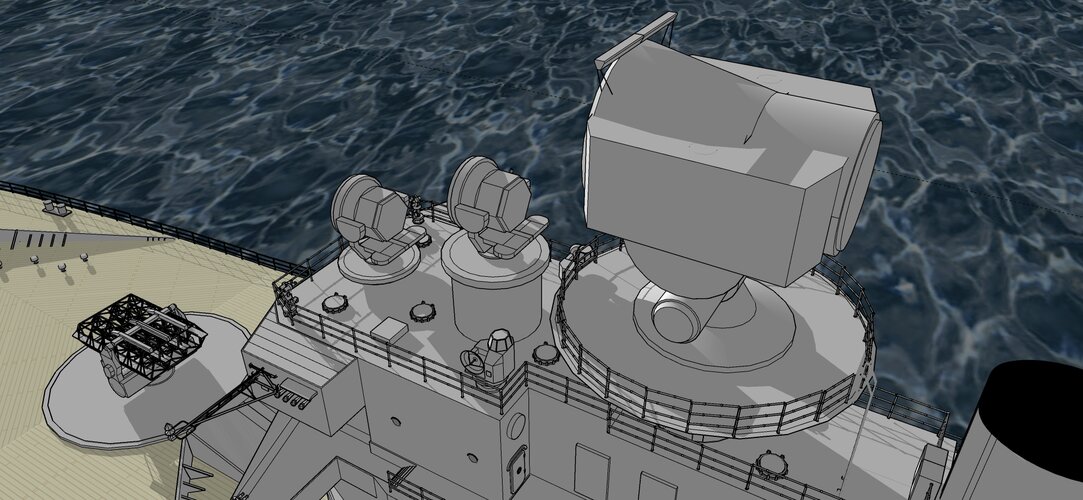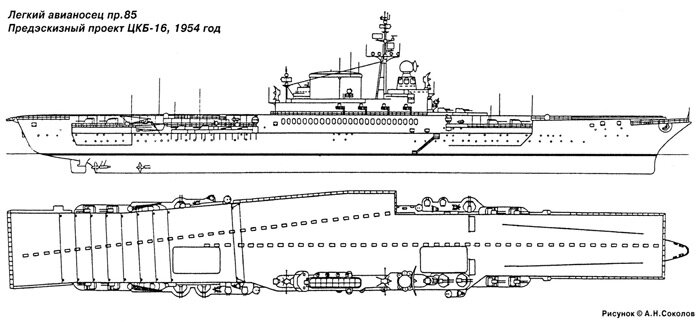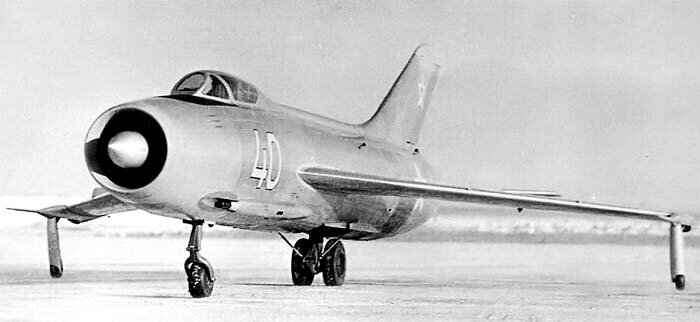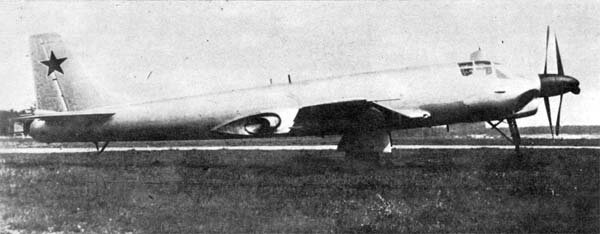Dilandu
I'm dissatisfied, which means, I exist.
(this ships is from the same AU as Lepanto-class missile battleships) The full description is on my Live Journal, on Russian.
The Suez crisis of 1956 became a moment of truth for the Royal Navy. It was impossible to deny anymore, that Great Britain is lagging dangerously behind both United States Navy and Soviet Navy in terms of missile armament and modern naval technology. With the exception of electronic equipment, all Royal Navy ships participating in Suez campaign were armed with essentially WW2 era weapon system - at best of dubious value in the age of jet bombers, atomics and cruise missiles. Again a potential Soviet attack, the Royal Navy in Mediterranean was virtually defenseless. The last hope - that carrier-based fighters of Fleet Air Arm would still be able to protect the warships - was quickly dashed, when USSR sucsessfully deployed in the Mediterranean it's first carrier battle group (composed of light carrier "Chkalov", fast battleship "Novorossysk" and "Stalingrad" heavy cruiser/battlecruiser).

The answer was obvious; the anti-air defense of Royal Navy must be increased as fast and as much as possible. Before 1956 the Royal Navy was content to wait till the special-purpose missile ships would be available. The Suez Crisis demonstrated, that it's not a viable option anymore. So the 1957 "White Paper" put a greater emphasis on increasing the fleet air defense. A pair of light cruiser - a "Superb" ("Minotaur"-class) and a "Lion" (still in construction, a "Tiger"-class) were chosen to receive the GWS.1 surface-to-air missile system - the Seaslug SAM - by 1960.
Still, it was going to be only a partial remedy. The partially-reconstructed light cruisers were supposed to have only one triple-rail launcher and two fire control radars each; MUCH better than nothing, but not exactly enough for sturdy air defense that RN desired. The more complex "two-end" reconstruction was out of question due to small size and limited displacement of British light cruisers. And Royal Navy did not have anything better. All its heavy cruisers were far too old and worn out to be of any use.
And so British admiral turned their attention to battleships:

There were still four "King George V"-class fast battleships in Royal Navy reserve. Despite being designed and ordered even before WW2, those 37.000-tons ships were still in relatively good condition, mothballed shortly after war. Their gun armament was outdated, of course, but their hulls were large and stable, and could handle any required modernization.
The calculations showed, that KGV-class units, retro-fitted into "ocean missile escort ships" could easily solve the problem of Royal Navy air defense. Each of them could handle two full-scale Seaslug SAM systems, with two fire control channels each (four in total) and other modern equipment. Such as Type 984 3D search radars, for example. In admiral's view, the modernized battleships would serve as air defense command platforms - coordinating the carrier group air defense, directing interceptors and other ships fire.
The initial plans were to rebuild all four KGV-class battleships. The economic reality and poor state of HMS "King George V" caused to rethink the plans. Eventually only the two newest battleships - HMS "Anson" and HMS "Howe" - were approved in 1958 for reconstruction. The rebuild ships were formally considered as just refitted KGV-class battleships, but actually Royal Navy always related to them as separate, "Anson"-class of missile battleships. They were the last capital ships commissioned for Royal Navy.

During the massive rebuild in 1958-1964, the old armament and superstructure of KGV-class units were completely dismantled. All three main gun turrets were removed along with barbettes, and a new, missile-centered armament was emplaced at bow and stern.
The main armament was, of course, the GWS.1 Seaslug surface-to air missile system. There were two of them; on bow and on stern. Each was composed of triple-rail launcher, a loading system, an under-deck magazine and two Type 901 fire control radars.
The triple tail launcher was actually a relic of early Seaslug development (when a salvo of three missiles was considered the minimal sufficient to take down high-flying bomber). On practice, the central rail was rarely used, because its reload caused the delay for the whole system. Usually, the central rail was reserved for a "special" missiles - either anti-surface "Red Slug" or nuclear "Blue Slug" (the latter could only be launched from central rail, which have the special locks compatible with nuclear-tipped missiles)

(sorry for typos, I used autotranslate)
The magazine system was specifically developed for KGV-class broad hulls. It was mainly placed below main armored deck, in place of former 14-inch and 4.5-inch shell & powder magazines. The only part above was a loader section, protected by 4-inch armor plating. Over the upper deck was an armored glasis through which the missiles were delivered to launcher.
The upper tier served as a loading compartment. It housed the swinging cradle of the loading device, which fed the missiles through hatches in the deck glass on the launcher rails. The ammunition stowage of three missiles, ready for instant loading, was also stored here. The missiles were fed to the loading positions with two lifts moving along the sides of the loading compartment along the rail guide located across the compartment.
The middle tier was used to store the ammunition ready for use. Here, 24 fully assembled and ready-to-use missiles are stored on two-tier racks. Two automatic transport trolleys moved along the rails laid across the compartment between the racks - which, according to the control system, extracted the missile selected for loading with the rack and moved it on the lifts. The same trolleys were used to install the missiles fed from the long-term storage section on the racks.
Finally, the lower tier was intended for long-term storage of disassembled missiles. Here, the missiles were stored on racks with their wings and stabilizers removed and the boosters dismantled — they were stored separately in containers. When the need arose to replenish the ready ammunition, the missiles were removed from the racks, switched on with the boosters, wings and stabilizers, and were fed on transport carts to the side elevators, moving the assembled missiles to the middle tier (for safety reasons, there was a handling compartment between the elevators of the lower and middle tiers).

The total capacity per system was, therefore, 72 missiles - 24 ready-to-use and 48 dismantled. The total ship's capacity was 144 missile of the follow types:
* Sea Slug — the basic version of the missile, using the "saddled beam" guidance method (i.e. the missile moved toward the target along a narrow rotating radar beam, automatically maintaining a position near the beam's rotation axis). It was equipped with a high-explosive fragmentation warhead weighing 90 kg.
* Homing Slug — a homing version of the missile, equipped with an adapted American interferometric semi-active radar homing head from the RIM-8 "Talos". The interferometer antennas were located on the wings. It was considered significantly more effective than the basic Sea Slug, but its high cost limited its deployment.
* Red Slug — a nuclear version of the missile, equipped with a 2-kiloton "Tony" warhead (a British version of the American W44). It was intended to destroy dense formations of bombers or maneuvering supersonic targets. Nuclear missiles had special safety systems that excluded the possibility of such a missile being accidentally fed to the launcher or launched unauthorized.
* Blue Slug is an anti-ship version of the missile, equipped with a radar altimeter (for low-altitude flight) and a heavier 135-kg (300-lb) semi-armor-piercing warhead. It was intended to fire at both enemy ships and coastal targets.
Both SAM's were controlled from two under-deck control room, each housing four digital POSEIDON computers. The semi-automatic ADAWS control system (Action Data Automation Weapon System) handled target tracking, indentification, classification, plotting and preparing of firing solution - both for the battleships, and for other escort units, equipped with compatible datalinks. The battleships were from the beginning designed to serve as air defense centers, on which smaller units would rely for coordination.
The secondary armament consisted of eight Mark 6 3-inch autocannons in dual mounts, four per broadside. They were controlled by eight Type 903 directors.

Initially the installation of STAAG 40-mm mounts was planned, but eventually cancelled due to small-caliber guns being considered of low value against jets and missiles.
The strike armament was fitted for but not with. It was initially composed of two hangars and cross-deck launch rail for the U.109BT «Red Rapier» jet flying bomb. Hovewer, by the time "Anson"-class units entered service, the «Red Rapier» was considered already obsolete and wasn't actually deployed on them.

Instead, the "Howe" in 1966 was retrofitted to carry four American-delivered RGM-6C cruise missiles. Those model of basic "Regulus I" included the ATRAN low altitude navigation system, adapted from land-based MGM-13 "Mace" missile. On British service, the missiles were armed with the «Orange Herald Small» 800-kt boosted fission warheads. Eventually, the strategic setup was only temporary, and was dismantled in 1970s.
The electronic equipment was centered around Type 984 radar on forward superstructure. This massive unit allowed for 3D search/track on long ranges - up to the 330 km. It was used for both early warning and airspace control.

For the purpose or redundancy, the battleships also received a setup of simpler Type 956 2D long-range search radar and Type 278 height-finder. A navigation Type 987 radar and a pair of Type 933 radars were installed to provide both surface and low-altitude aerial targeting.
The powerplant remained generally the same, albeit partially automated to reduce crew demands. The initial plans for partial replacement of boilers with gas turbines were abandoned due to cost & time constrains and the fact that both battleships turbines and boilers were found to be in good condition.

The "Anson" entered (actually re-entered, but by this time Royal Navy dropped the "it's just a modernization" point and started to officially consider missile battleships as new, separate class) serive in January 1964 - two years past initially planned date - but trials and post-completion works took another half of the year. The "Howe", similarly, was delivered in November 1964, but actually declared combat-capable only by summer 1965.
During their long career, both battleships served mainly as missile escort for "Eagle" and "Ark Royal" carriers, centering their air defense. Several modernizations were undertaken:
* The rear superfiring 3-inch guns were replaced with Sea Cat SAM's in 1968-1970
* The Seaslug SAM was refitted to Mk-2 standard by 1972
* The Type 984 radar was subjected to several major refit, including digitalization by 1970s. There were some plans to replace it with more advanced types, but superior performance of Type 984 was hard to beat.
* The "Howe" was experimentally fitted with helicopter pad on stern and a collapsible Canadian-type hangar for one helicopter, but the setup was considered unsuscsessfull - it severly limited the rear launcher fire arc, and the missile booster exhaust damaged the helicopter
The only actual battle service performed by Royal Navy missile battleships was the "Anson" deployment on Pacific in 1975, to support the Australia during the Third Australo-Indonesian confrontation. October 14. 1975, the battleships used its "Seaslug" missiles first and last time against real action - shooting down the pilotless recon drone of Tu-143 type, that Indonesians used to harrass the Royal Navy group. After initial attempt to intercept drone by deck fighter failed, the "Anson" fired two "Seaslug" missiles, knocking drone down with "rather spectacular" direct hit.

The "Anson" was removed from service in 1978 and turned into training ship for missile exercises. The "Howe" served till 1980, till the increasing problems with her elderly powerplant caused Navy to decomission her also. During Falkland War of 1982, both battleships were briefly inspected for possible reactivation, but "Anson" was deemed in need of major hull repair, and "Howe" required powerplant restoration (not to mention that both ships were manpower-demanding). Some equipment from "Anson" were used for the repair of "Superb" missile cruiser SAM systems.
During late 1980s, the first and last Royal Navy missile battleships were scrapped. The launcher, two Type 901 radars and Type 984 radar from "Anson" were retained as land-based memorial complex.
The Suez crisis of 1956 became a moment of truth for the Royal Navy. It was impossible to deny anymore, that Great Britain is lagging dangerously behind both United States Navy and Soviet Navy in terms of missile armament and modern naval technology. With the exception of electronic equipment, all Royal Navy ships participating in Suez campaign were armed with essentially WW2 era weapon system - at best of dubious value in the age of jet bombers, atomics and cruise missiles. Again a potential Soviet attack, the Royal Navy in Mediterranean was virtually defenseless. The last hope - that carrier-based fighters of Fleet Air Arm would still be able to protect the warships - was quickly dashed, when USSR sucsessfully deployed in the Mediterranean it's first carrier battle group (composed of light carrier "Chkalov", fast battleship "Novorossysk" and "Stalingrad" heavy cruiser/battlecruiser).
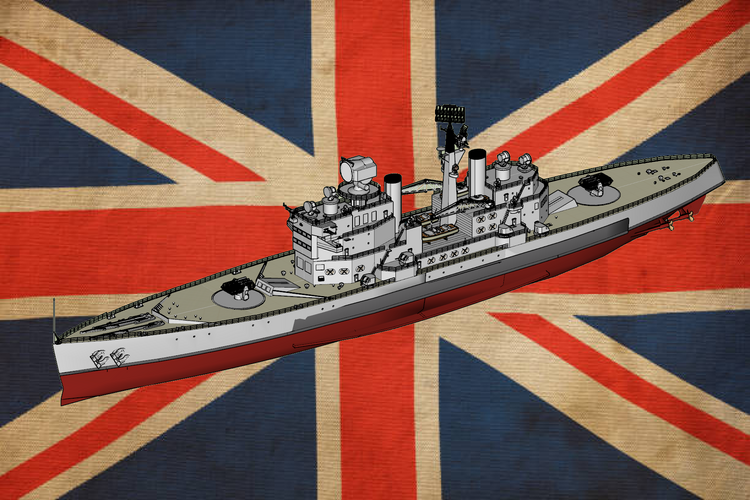
The answer was obvious; the anti-air defense of Royal Navy must be increased as fast and as much as possible. Before 1956 the Royal Navy was content to wait till the special-purpose missile ships would be available. The Suez Crisis demonstrated, that it's not a viable option anymore. So the 1957 "White Paper" put a greater emphasis on increasing the fleet air defense. A pair of light cruiser - a "Superb" ("Minotaur"-class) and a "Lion" (still in construction, a "Tiger"-class) were chosen to receive the GWS.1 surface-to-air missile system - the Seaslug SAM - by 1960.
Still, it was going to be only a partial remedy. The partially-reconstructed light cruisers were supposed to have only one triple-rail launcher and two fire control radars each; MUCH better than nothing, but not exactly enough for sturdy air defense that RN desired. The more complex "two-end" reconstruction was out of question due to small size and limited displacement of British light cruisers. And Royal Navy did not have anything better. All its heavy cruisers were far too old and worn out to be of any use.
And so British admiral turned their attention to battleships:
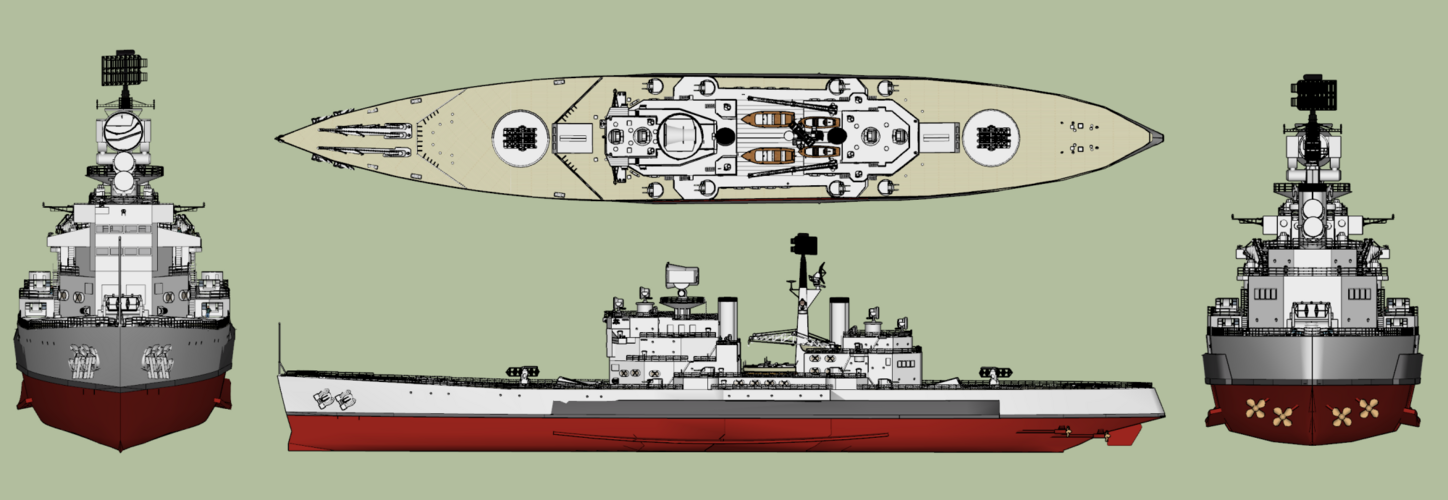
There were still four "King George V"-class fast battleships in Royal Navy reserve. Despite being designed and ordered even before WW2, those 37.000-tons ships were still in relatively good condition, mothballed shortly after war. Their gun armament was outdated, of course, but their hulls were large and stable, and could handle any required modernization.
The calculations showed, that KGV-class units, retro-fitted into "ocean missile escort ships" could easily solve the problem of Royal Navy air defense. Each of them could handle two full-scale Seaslug SAM systems, with two fire control channels each (four in total) and other modern equipment. Such as Type 984 3D search radars, for example. In admiral's view, the modernized battleships would serve as air defense command platforms - coordinating the carrier group air defense, directing interceptors and other ships fire.
The initial plans were to rebuild all four KGV-class battleships. The economic reality and poor state of HMS "King George V" caused to rethink the plans. Eventually only the two newest battleships - HMS "Anson" and HMS "Howe" - were approved in 1958 for reconstruction. The rebuild ships were formally considered as just refitted KGV-class battleships, but actually Royal Navy always related to them as separate, "Anson"-class of missile battleships. They were the last capital ships commissioned for Royal Navy.
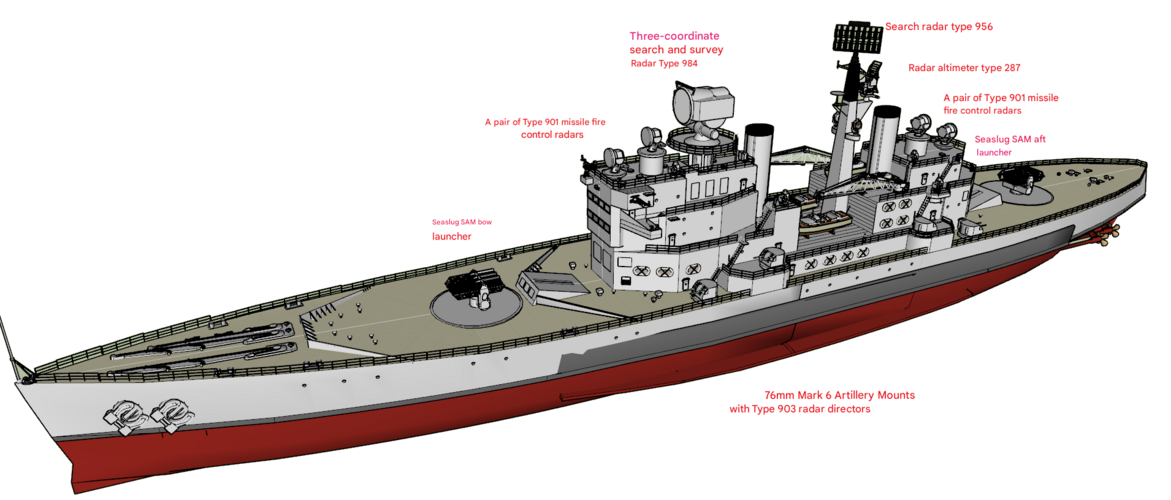
During the massive rebuild in 1958-1964, the old armament and superstructure of KGV-class units were completely dismantled. All three main gun turrets were removed along with barbettes, and a new, missile-centered armament was emplaced at bow and stern.
The main armament was, of course, the GWS.1 Seaslug surface-to air missile system. There were two of them; on bow and on stern. Each was composed of triple-rail launcher, a loading system, an under-deck magazine and two Type 901 fire control radars.
The triple tail launcher was actually a relic of early Seaslug development (when a salvo of three missiles was considered the minimal sufficient to take down high-flying bomber). On practice, the central rail was rarely used, because its reload caused the delay for the whole system. Usually, the central rail was reserved for a "special" missiles - either anti-surface "Red Slug" or nuclear "Blue Slug" (the latter could only be launched from central rail, which have the special locks compatible with nuclear-tipped missiles)

(sorry for typos, I used autotranslate)
The magazine system was specifically developed for KGV-class broad hulls. It was mainly placed below main armored deck, in place of former 14-inch and 4.5-inch shell & powder magazines. The only part above was a loader section, protected by 4-inch armor plating. Over the upper deck was an armored glasis through which the missiles were delivered to launcher.
The upper tier served as a loading compartment. It housed the swinging cradle of the loading device, which fed the missiles through hatches in the deck glass on the launcher rails. The ammunition stowage of three missiles, ready for instant loading, was also stored here. The missiles were fed to the loading positions with two lifts moving along the sides of the loading compartment along the rail guide located across the compartment.
The middle tier was used to store the ammunition ready for use. Here, 24 fully assembled and ready-to-use missiles are stored on two-tier racks. Two automatic transport trolleys moved along the rails laid across the compartment between the racks - which, according to the control system, extracted the missile selected for loading with the rack and moved it on the lifts. The same trolleys were used to install the missiles fed from the long-term storage section on the racks.
Finally, the lower tier was intended for long-term storage of disassembled missiles. Here, the missiles were stored on racks with their wings and stabilizers removed and the boosters dismantled — they were stored separately in containers. When the need arose to replenish the ready ammunition, the missiles were removed from the racks, switched on with the boosters, wings and stabilizers, and were fed on transport carts to the side elevators, moving the assembled missiles to the middle tier (for safety reasons, there was a handling compartment between the elevators of the lower and middle tiers).
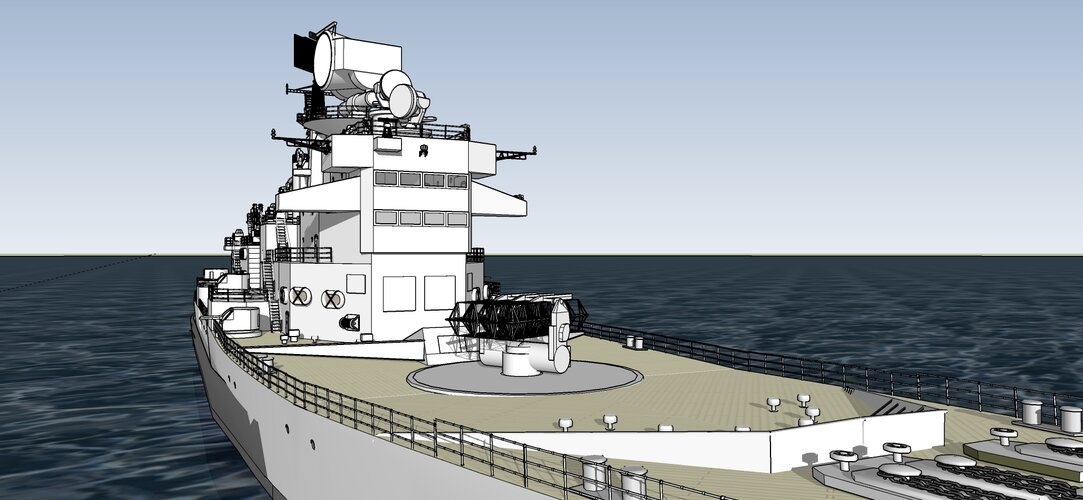
The total capacity per system was, therefore, 72 missiles - 24 ready-to-use and 48 dismantled. The total ship's capacity was 144 missile of the follow types:
* Sea Slug — the basic version of the missile, using the "saddled beam" guidance method (i.e. the missile moved toward the target along a narrow rotating radar beam, automatically maintaining a position near the beam's rotation axis). It was equipped with a high-explosive fragmentation warhead weighing 90 kg.
* Homing Slug — a homing version of the missile, equipped with an adapted American interferometric semi-active radar homing head from the RIM-8 "Talos". The interferometer antennas were located on the wings. It was considered significantly more effective than the basic Sea Slug, but its high cost limited its deployment.
* Red Slug — a nuclear version of the missile, equipped with a 2-kiloton "Tony" warhead (a British version of the American W44). It was intended to destroy dense formations of bombers or maneuvering supersonic targets. Nuclear missiles had special safety systems that excluded the possibility of such a missile being accidentally fed to the launcher or launched unauthorized.
* Blue Slug is an anti-ship version of the missile, equipped with a radar altimeter (for low-altitude flight) and a heavier 135-kg (300-lb) semi-armor-piercing warhead. It was intended to fire at both enemy ships and coastal targets.
Both SAM's were controlled from two under-deck control room, each housing four digital POSEIDON computers. The semi-automatic ADAWS control system (Action Data Automation Weapon System) handled target tracking, indentification, classification, plotting and preparing of firing solution - both for the battleships, and for other escort units, equipped with compatible datalinks. The battleships were from the beginning designed to serve as air defense centers, on which smaller units would rely for coordination.
The secondary armament consisted of eight Mark 6 3-inch autocannons in dual mounts, four per broadside. They were controlled by eight Type 903 directors.
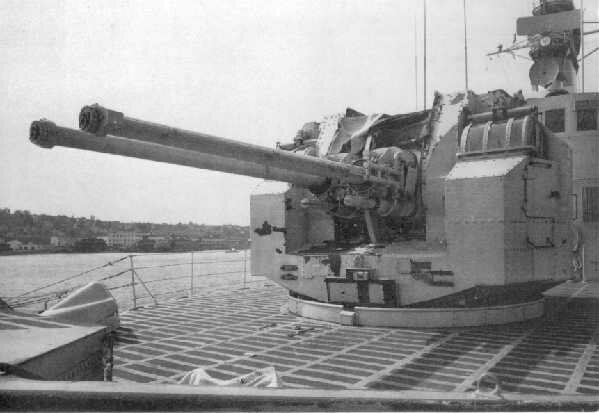
Initially the installation of STAAG 40-mm mounts was planned, but eventually cancelled due to small-caliber guns being considered of low value against jets and missiles.
The strike armament was fitted for but not with. It was initially composed of two hangars and cross-deck launch rail for the U.109BT «Red Rapier» jet flying bomb. Hovewer, by the time "Anson"-class units entered service, the «Red Rapier» was considered already obsolete and wasn't actually deployed on them.
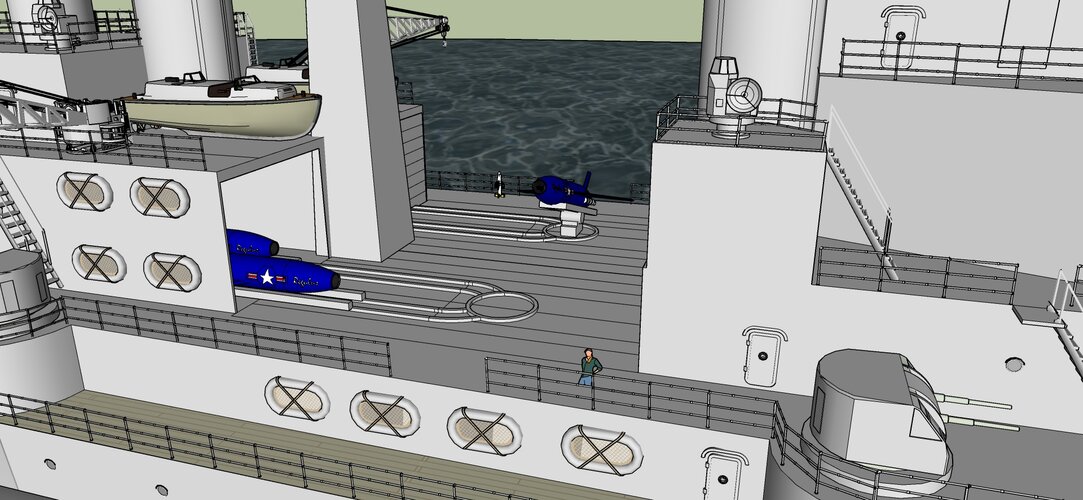
Instead, the "Howe" in 1966 was retrofitted to carry four American-delivered RGM-6C cruise missiles. Those model of basic "Regulus I" included the ATRAN low altitude navigation system, adapted from land-based MGM-13 "Mace" missile. On British service, the missiles were armed with the «Orange Herald Small» 800-kt boosted fission warheads. Eventually, the strategic setup was only temporary, and was dismantled in 1970s.
The electronic equipment was centered around Type 984 radar on forward superstructure. This massive unit allowed for 3D search/track on long ranges - up to the 330 km. It was used for both early warning and airspace control.
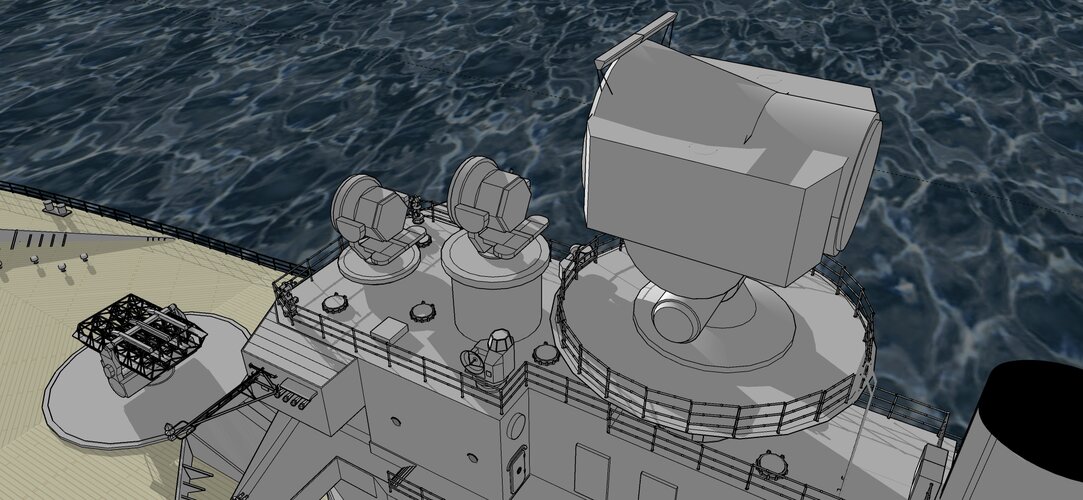
For the purpose or redundancy, the battleships also received a setup of simpler Type 956 2D long-range search radar and Type 278 height-finder. A navigation Type 987 radar and a pair of Type 933 radars were installed to provide both surface and low-altitude aerial targeting.
The powerplant remained generally the same, albeit partially automated to reduce crew demands. The initial plans for partial replacement of boilers with gas turbines were abandoned due to cost & time constrains and the fact that both battleships turbines and boilers were found to be in good condition.
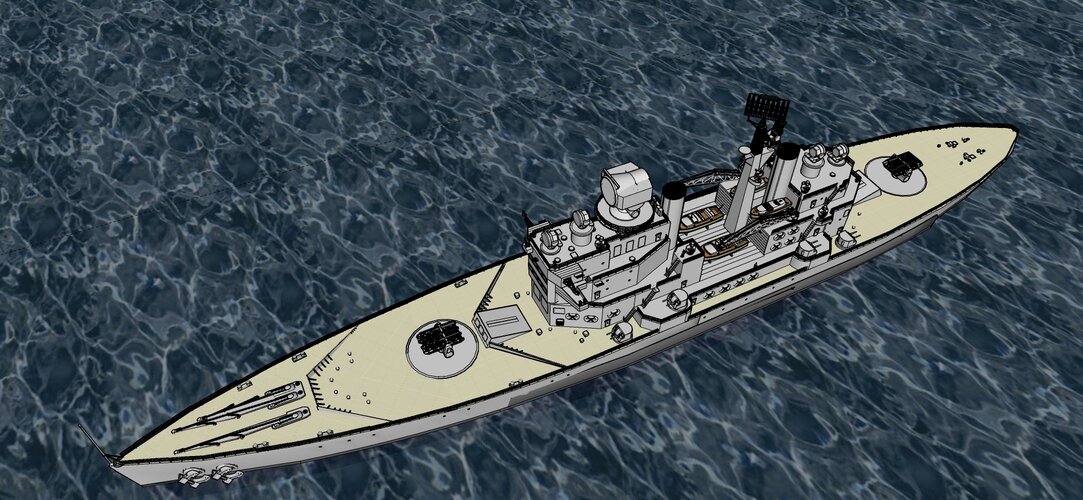
The "Anson" entered (actually re-entered, but by this time Royal Navy dropped the "it's just a modernization" point and started to officially consider missile battleships as new, separate class) serive in January 1964 - two years past initially planned date - but trials and post-completion works took another half of the year. The "Howe", similarly, was delivered in November 1964, but actually declared combat-capable only by summer 1965.
During their long career, both battleships served mainly as missile escort for "Eagle" and "Ark Royal" carriers, centering their air defense. Several modernizations were undertaken:
* The rear superfiring 3-inch guns were replaced with Sea Cat SAM's in 1968-1970
* The Seaslug SAM was refitted to Mk-2 standard by 1972
* The Type 984 radar was subjected to several major refit, including digitalization by 1970s. There were some plans to replace it with more advanced types, but superior performance of Type 984 was hard to beat.
* The "Howe" was experimentally fitted with helicopter pad on stern and a collapsible Canadian-type hangar for one helicopter, but the setup was considered unsuscsessfull - it severly limited the rear launcher fire arc, and the missile booster exhaust damaged the helicopter
The only actual battle service performed by Royal Navy missile battleships was the "Anson" deployment on Pacific in 1975, to support the Australia during the Third Australo-Indonesian confrontation. October 14. 1975, the battleships used its "Seaslug" missiles first and last time against real action - shooting down the pilotless recon drone of Tu-143 type, that Indonesians used to harrass the Royal Navy group. After initial attempt to intercept drone by deck fighter failed, the "Anson" fired two "Seaslug" missiles, knocking drone down with "rather spectacular" direct hit.
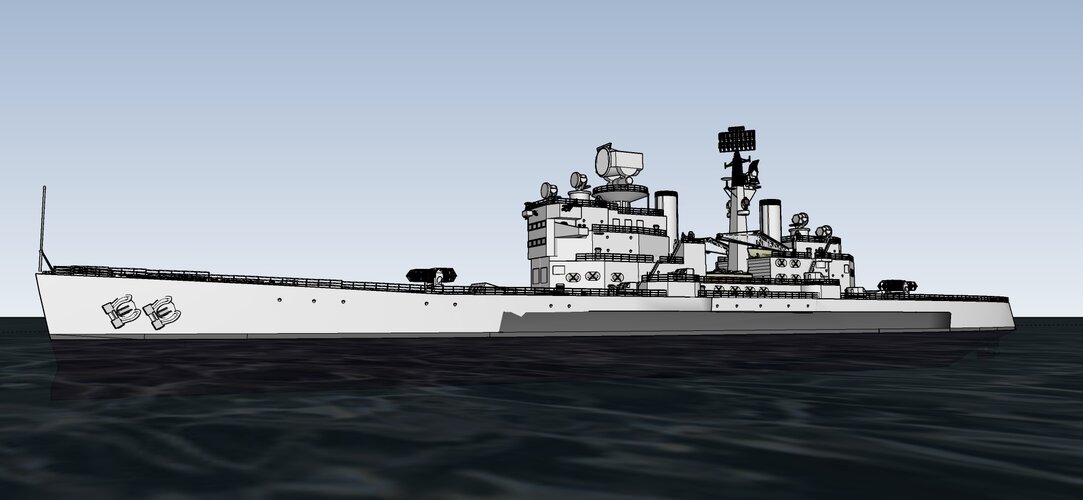
The "Anson" was removed from service in 1978 and turned into training ship for missile exercises. The "Howe" served till 1980, till the increasing problems with her elderly powerplant caused Navy to decomission her also. During Falkland War of 1982, both battleships were briefly inspected for possible reactivation, but "Anson" was deemed in need of major hull repair, and "Howe" required powerplant restoration (not to mention that both ships were manpower-demanding). Some equipment from "Anson" were used for the repair of "Superb" missile cruiser SAM systems.
During late 1980s, the first and last Royal Navy missile battleships were scrapped. The launcher, two Type 901 radars and Type 984 radar from "Anson" were retained as land-based memorial complex.

